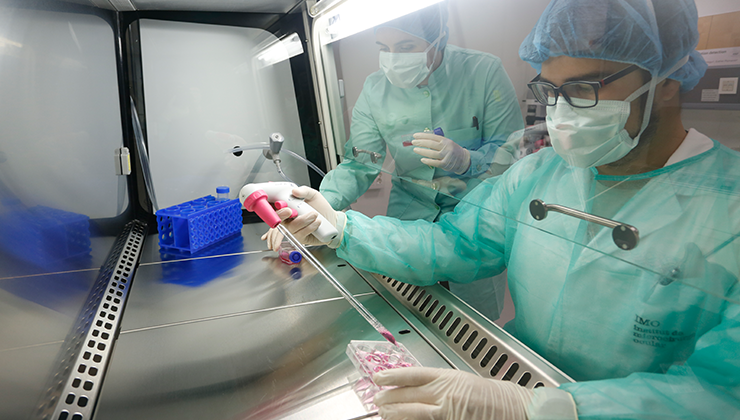Since June, IMO Foundation counts on a new Cell Culture and New Therapies Testing Area, part of the molecular biology lab of the Institute. With this new area, equipped with the latest technology and the strictest sterility and security measures required for this kind of activity, IMO bets decisively for the translational medicine to experiment with future gene and stem-cell therapies obtained from the genetic investigation currently on the go.
It is the first time that an area of investigation with these features belongs to an ophthalmological center in Catalonia, a hallmark achieved four years after the inauguration of a lab where a complete service of genetic diagnosis of ophthalmological inherited diseases is offered in situ. Moreover, the lab is where basic investigation projects promoted by IMO Foundation are held, mainly oriented to the study of molecular bases of ocular pathologies from genetic origin.
Functional studies
The activity of the new culture’s area starts with the development of tests based on cellular models where pathogenic impact of new mutations previously identified in patients will be accurately studied (which role do they play in the appearance of a specific disease). Furthermore, this is the first study in the new culture area that will allow us to verify if the altered gene is not expressed or if it is expressed incorrectly. This information is essential to design and personalize future therapies, indicating, for example, if the best strategy is to block the defective gene or if it is better to insert a new healthy one.
The tests will be done with cells from different human tissues due to the difficulties to work with retinal cells, because they are neurons and cannot be divided. Already identified mutations will be forced to be expressed to study their impact in cells. “We create functional models from the already described variants as potentially pathologic to confirm its harmful effect and to exactly determinate what alterations they may cause”, says Dr. Esther Pomares, responsible of the Genetics Department of the Institute and main researcher of the basic studies carried out by IMO Foundation.

With the Cell Culture and New Therapies Testing Area, inaugurated on June 14th, IMO Foundation is getting ready to design and personalize future gene and cellular therapies.
Cellular and gene therapies
The culture area will allow in situ testing with gene and cellular therapies, two different types of treatments in experimental phase, which are not mutually exclusive and can be complementary. Gene therapy, whose application might start in 4 or 5 years, is expected to stop the progress of vision degenerative diseases (mainly retinal dystrophy) by either introducing a healthy gene to replace the altered gene’s function or blocking it if that gene is harmful for the cell. A previous study of its originating cause is essential to implement these therapies, which is already on the go and will be improved with detailed analysis in the culture room.
Moreover, cellular therapy – based on implanting healthy cells into the tissues of the affected patient – will predictably allow vision recovery. IMO Foundation is expecting to start other related studies in the new culture area with already planned projects thanks to the sponsorship of private entities, which help financing this kind of studies due to their elevated cost. In this way, there is a possibility to stop the evolution of certain diseases associated to the loss of vision.